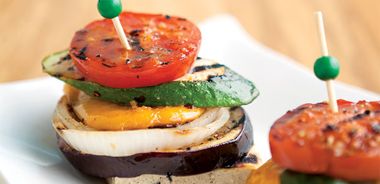Tofu Vegetable Stacks

These attractive veggie stacks are a meal unto themselves. Serve as a nice summer lunch with a scoop of quinoa salad on the side.
2 Tbsp (30 mL) fresh squeezed lime juice
1 Tbsp (15 mL) extra-virgin olive oil
1 tsp (5 mL) toasted sesame oil
1 tsp (5 mL) tamari soy sauce
1 tsp (5 mL) maple syrup
1 large garlic clove, smashed and finely minced
Generous pinch crushed red chilies
1 package (350 g) organic extra-firm tofu, cut into 4 slabs and pressed*
1/2 medium-sized eggplant, skin on, cut into 4 - 1/2 in (1.25 cm) rounds
1/2 Vidalia onion, peeled and cut into 4 slices
1 large yellow pepper, cored and cut into 4 pieces
1 zucchini, cut into 4 thick diagonal slices
1 firm tomato, cut into 4 slices
4 - 4 in (10 cm) bamboo skewers
Combine lime juice, olive oil, sesame oil, tamari, maple syrup, garlic, and chilies in large bowl. Whisk to blend. Place tofu and vegetables in single layer on large baking sheet and brush with lime dressing on both sides.
Preheat barbecue to medium-high heat and grease grill. Place tofu and vegetables on grill in single layer. Grill, turning once, until tender and lightly charred. Remove to baking sheet as they are done, about 10 to 15 minutes.
To serve, create 4 vegetable stacks layering tofu and vegetables one on top of the other and secure in the centre with bamboo skewer. Drizzle with any remaining lime dressing and season lightly with fresh ground black pepper.
Serves 4.
* For crispy grilled tofu, cut into slabs and place in single layer on clean kitchen cloth. Cover with clean cloth and gently press tofu with the palm of your hand to extract extra water.
Each serving contains: 129 calories; 9 g protein; 6 g total fat (1 g sat. fat, 0 g trans fat); 14 g total carbohydrates (6 g sugars, 4 g fibre); 178 mg sodium
source: "Vegan Barbecue Feast", alive #380, June 2014





